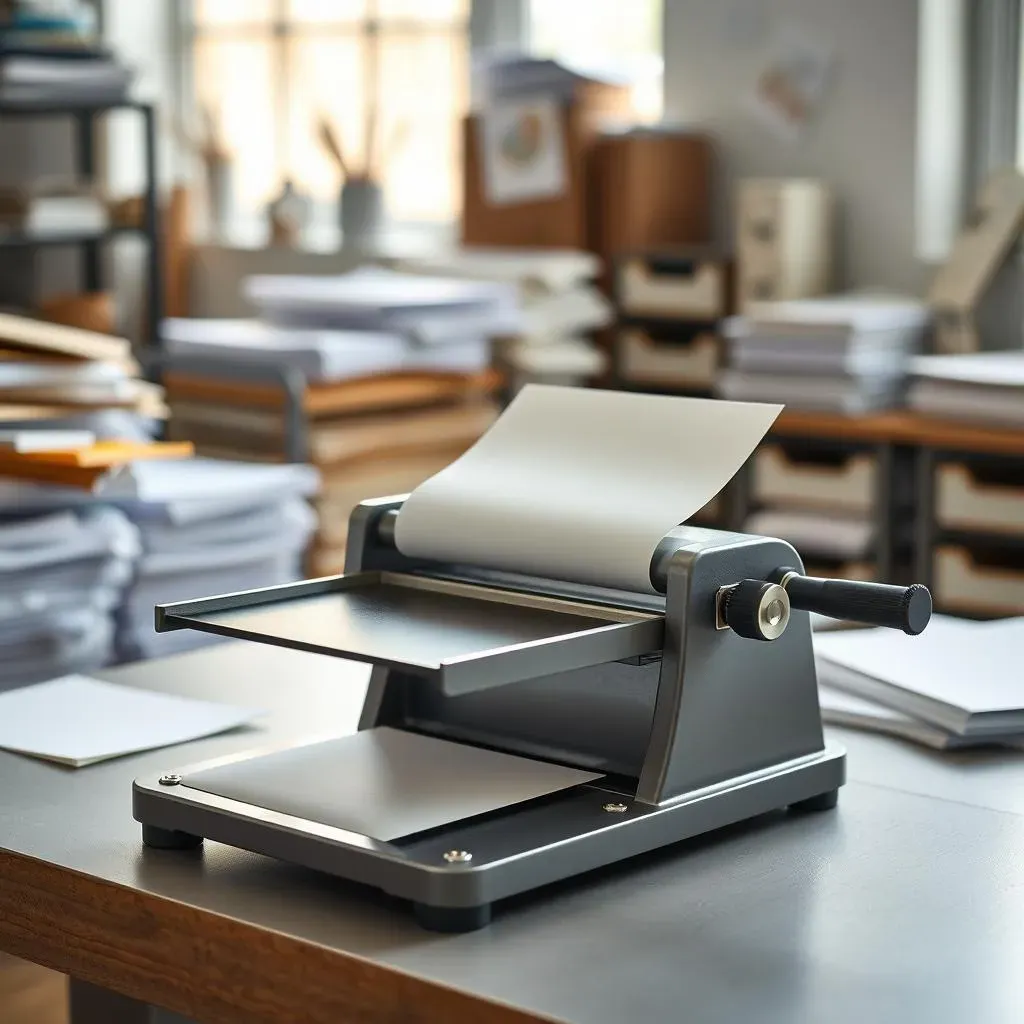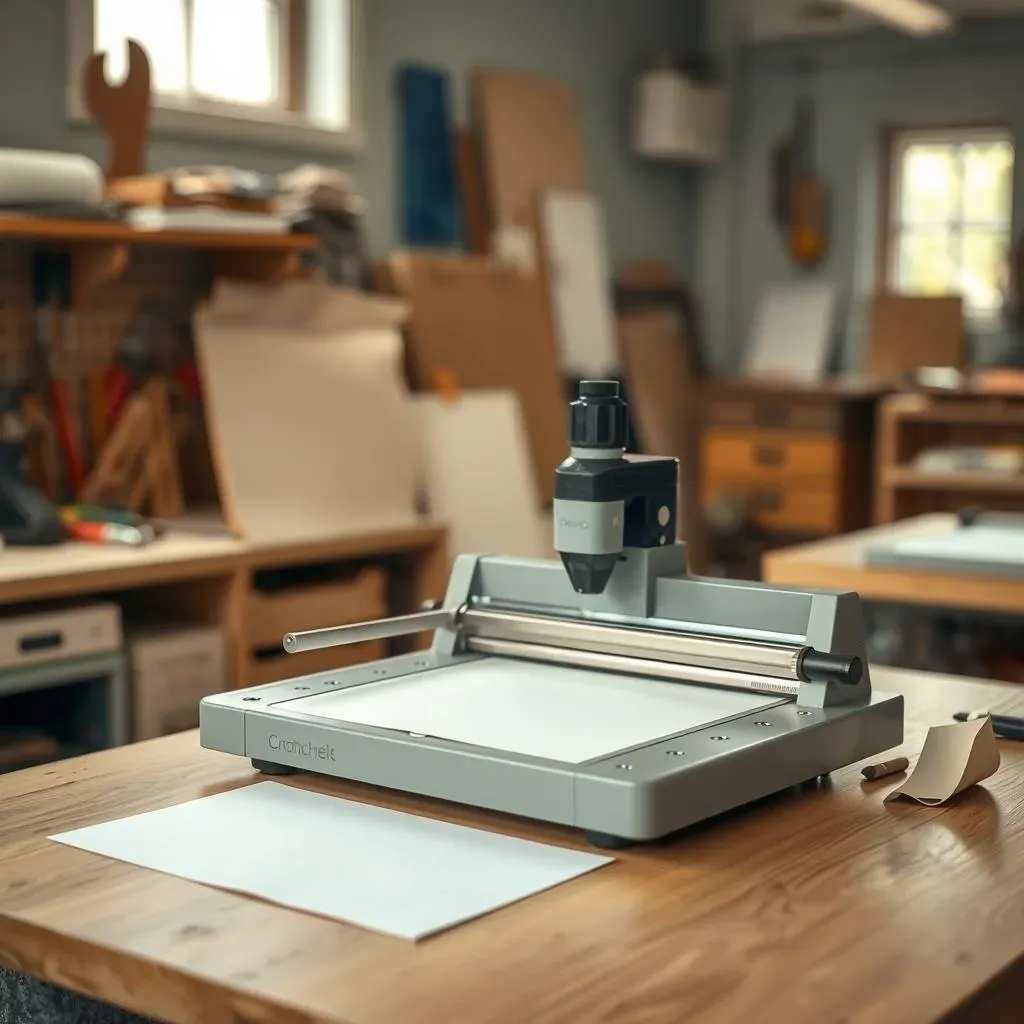Table of Contents
Are you ready to elevate your paper crafting, scrapbooking, or office tasks to a whole new level of precision? Then you've come to the right place! This comprehensive guide will equip you with everything you need to know about the trusty manual paper cutting machine. We'll explore the world of manual paper cutting machines, helping you choose the perfect model to suit your needs and budget. Forget those frustrating, uneven cuts from ordinary scissors; we'll delve into effective techniques for achieving consistently clean, precise lines every time. From selecting the right blade to mastering the art of accurate alignment, this guide will transform you into a paper-cutting pro. But the journey doesn't end there. We'll also cover essential maintenance tips to ensure your manual paper cutting machine remains a reliable workhorse for years to come. Whether you're a seasoned crafter or a complete beginner, this guide will empower you to unlock the full potential of your manual paper cutting machine. Prepare to discover the joy of precise, efficient, and satisfying paper cutting – let's get started!
Choosing the Right Manual Paper Cutting Machine
Choosing the Right Manual Paper Cutting Machine
Cutting Capacity: How Much Paper Do You Need to Cut?
First things first: Think about how much paper you typically cut at once. Are we talking a few sheets for personal projects, or stacks of 100+ for a business? A smaller, lighter manual paper cutting machine will work perfectly for occasional use or small-scale projects. If you're dealing with large volumes, however, you'll need a heavier-duty model with a larger cutting capacity. Consider the paper weight too; thicker cardstock or multiple sheets require a machine built to handle the pressure. Don't underestimate the importance of this; choosing the wrong capacity leads to frustration and potentially damaged equipment.
Remember, a larger cutting capacity usually means a larger machine. Think about your workspace – do you have enough room for a bigger machine? If space is limited, a smaller, more compact model might be a better fit despite having a slightly lower cutting capacity. It's all about finding the sweet spot between your needs and your available space. Don't just focus on the numbers; think practically about your workflow.
Cutting Capacity (Sheets) | Recommended Use |
|---|---|
10-20 | Personal crafting, small office tasks |
50-100 | Larger office projects, frequent use |
100+ | High-volume printing, commercial use |
Size and Features: What Are Your Must-Haves?
Next, consider the size and additional features. How much space do you have available on your desk or in your workspace? Some manual paper cutting machines are compact and ideal for desktops, while others are larger floor models. Think about your budget too – some machines include features like adjustable cutting guides, safety features like blade guards, and even built-in rulers. These features can significantly improve accuracy and safety, but they also often come with a higher price tag. A simple, no-frills machine might be all you need if you're on a tight budget and are comfortable with a more basic setup.
Consider the materials of the machine itself. A sturdy base is crucial for stability and accuracy; a wobbly machine leads to uneven cuts. Look for machines made from durable materials like metal or reinforced plastic. Also, take note of the blade type and how easy it is to change. A sharp, easy-to-replace blade is essential for clean cuts and long-term use. Don't forget to look at user reviews! Real-world experiences from other users can provide invaluable insights into a machine's durability, ease of use, and overall performance.
- Cutting Guides (adjustable)
- Safety Features (blade guard)
- Built-in Ruler
- Material of Construction (metal, plastic)
- Blade Type and Replaceability
Techniques and Tips for Precise Cuts with Your Manual Paper Cutting Machine
Techniques and Tips for Precise Cuts with Your Manual Paper Cutting Machine
Mastering the Cut: Technique is Key
Let's get down to the nitty-gritty of actually using your manual paper cutting machine. The first thing to remember is that it's not a race! Slow, deliberate movements are your best friends here. Start by carefully aligning your paper with the cutting guides. Make sure it's straight and even; this is the foundation for a perfect cut. Use the paper clamp firmly, but not so tightly that you damage the paper. A secure grip prevents slippage, which can lead to crooked cuts. Then, with a smooth, controlled motion, bring down the blade. Don't force it; let the weight of the blade do the work. A jerky movement will likely lead to a tear or an uneven cut. Practice makes perfect, so don't get discouraged if your first few attempts aren't flawless.
Think of it like this: you're not just cutting paper; you're sculpting it. Each movement should be precise and intentional. Try to maintain a consistent speed and pressure throughout the cutting process. This consistency will result in cleaner cuts, especially when working with thicker materials. It's also a good idea to use a cutting mat or board underneath your paper; this protects your work surface and provides a stable base for the machine. Regular cleaning of your machine's blade and guides will help maintain its sharpness and precision. A dull blade is a recipe for disaster!
Step | Action |
|---|---|
1 | Align paper with guides |
2 | Secure with clamp |
3 | Smooth, controlled blade movement |
4 | Remove cut paper |
Troubleshooting Common Cutting Issues
Even with the best techniques, you might encounter some challenges. Let's address some common problems and their solutions. Uneven cuts are often caused by a dull blade, inconsistent pressure, or a loose clamp. Replace a dull blade immediately; using a dull blade will only lead to more frustration. If your cuts are consistently crooked, double-check your paper alignment before each cut. Sometimes, a slight adjustment can make all the difference. Paper jams can happen, especially with thicker stacks. Make sure you're not overloading the machine, and gently work the paper free if a jam occurs. Never force the machine; this could damage it.
Remember, patience is key! Don't rush the process, and take your time to ensure each cut is accurate. With practice, you'll develop a feel for the machine and become more efficient. A little bit of preventative maintenance goes a long way. Regularly cleaning the blade and guides helps to keep your machine in top shape. If you are consistently having problems, consult your machine's manual for troubleshooting tips specific to your model.
- Uneven Cuts: Dull blade, inconsistent pressure, loose clamp.
- Crooked Cuts: Incorrect paper alignment.
- Paper Jams: Overloading the machine.
Maintaining Your Manual Paper Cutting Machine for Longevity
Maintaining Your Manual Paper Cutting Machine for Longevity
Regular Cleaning and Maintenance
Okay, so you've mastered the art of precise cuts. But to keep your manual paper cutting machine performing at its peak, regular maintenance is essential. Think of it like this: a well-maintained machine is a happy machine, and a happy machine produces consistently perfect cuts. Start by regularly cleaning the blade. A simple wipe-down with a soft cloth after each use helps remove paper dust and debris. For a deeper clean, you might use a specialized blade cleaner or even a soft brush to remove stubborn particles. A dull blade is a disaster waiting to happen; maintaining its sharpness is crucial for precise cuts. Don't forget the cutting guides! These can also accumulate dust and debris, affecting accuracy. Wipe them down regularly to ensure smooth, consistent paper alignment.
And speaking of sharpness, consider the blade itself. Over time, even with careful use, blades will become dull. A dull blade leads to uneven cuts, increased effort, and potential damage to the machine. Replacing the blade is straightforward for most models; check your user manual for instructions. A sharp blade is the foundation of precise cuts, so don't skimp on replacing it when necessary. It's a small investment that protects your machine and your work. This isn't just about keeping it clean; it's about extending its lifespan. You've invested in a quality tool; treat it well and it'll reward you with years of service.
Maintenance Task | Frequency | Tools |
|---|---|---|
Blade Cleaning | After each use | Soft cloth, brush |
Guide Cleaning | Weekly | Soft cloth |
Blade Replacement | As needed (when dull) | Replacement blade |
Storage and Handling
Proper storage and handling are crucial for preserving your manual paper cutting machine's longevity. When not in use, store your machine in a clean, dry place, away from direct sunlight and extreme temperatures. This prevents rust, corrosion, and damage to the machine's components. Cover it with a protective cloth or cover to keep it dust-free. If you have a larger floor model, consider a dedicated storage space to protect it from accidental bumps or knocks. Always handle the machine with care. Avoid dropping or slamming it, as this can damage the internal mechanisms or the blade.
Remember, your manual paper cutting machine is a precision instrument. Treat it with respect, and it'll reward you with years of reliable service. Think of it as an investment that pays off with consistent, accurate cuts for all your paper projects. Regular maintenance, careful handling, and proper storage are your best friends in ensuring that your manual paper cutting machine remains a reliable and accurate tool for years to come. A little preventative care goes a long way!
- Store in a clean, dry location
- Protect from sunlight and extreme temperatures
- Cover with a protective cloth
- Handle with care; avoid dropping or slamming